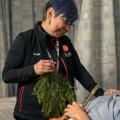Angioplasty with stent
Learn more about what to expect during an angioplasty.
Overview
Angioplasty widens clogged or narrow heart arteries (large blood vessels). These arteries are often narrowed by cholesterol deposits (plaque).
Angioplasty is a medical procedure, not a surgery. During this procedure, a small balloon gently expands the artery. Sometimes, a special device called a "stent" is also used to keep the artery open. Doctors often perform angioplasty at the same time as an angiogram if necessary.
What is a stent?
A stent is a tiny, metallic mesh tube. A heart specialist (cardiologist) places it into your blood vessel using a small tube with a balloon at the end. The stent gets bigger as the balloon fills with air, pressing against the blood vessel walls. Once the balloon is deflated and removed, the stent remains in place permanently. It ensures the blood vessel stays open and improves the flow of blood. Stents reduce the chances of the area narrowing again. Your doctor will choose from different stent types to find the best one for your condition.
Preparing for the procedure
To prepare for this procedure, the doctor may ask you to do one or more tests. You can learn more about them here.
During the procedure
During the angioplasty, the cardiologist inserts a catheter (tube) with a balloon at the tip. Once the catheter is placed at the site of the blockage, the balloon inflates and deflates until the blockage is pushed out of the way. The balloon pushes the plaque against the artery. This makes more room for the blood flow.
Angioplasty is often combined with the placement of a stent. The procedure is similar to balloon angioplasty. It uses a stent to keep the artery permanently open.
You might feel some mild chest discomfort during the inflation of the balloon as it temporarily blocks the blood flow in the artery. This will go away a few minutes later once the balloon is deflated and removed. The stent stays in the artery permanently and works to hold it open. This improves blood flow to the heart muscle and relieves symptoms such as chest pain.
After the procedure
The instructions for after your angioplasty is the same as for an angiogram. Read the patient education materials below to learn more.
Support for Indigenous Peoples
The Indigenous Wellness Liaison Team is here to support your health journey. Team members offer cultural support and healthcare advocacy. Learn more below or call them at 604-682-2344,62937 or email IWL@providencehealth.bc.ca.
Education & resources
Location
Cardiac Short Stay & Outpatient Clinic
5th Floor, Providence Building, St. Paul's Hospital
- Follow the blue line to the West Elevator (Providence Building) or take elevators from the parkade
- Take elevators to 5th floor (5C) - Cardiac Short Stay & Outpatient Clinics
- Report to Reception
Transportation & parking
Remember to allow time to get from your car or transit to the hospital. When you arrive at St. Paul’s Hospital, enter through the main doors off Burrard Street. If you are not sure where to go, ask a volunteer or the Information Desk for directions to the Cardiology Short Stay. Tell them you’re here for an angiogram.
